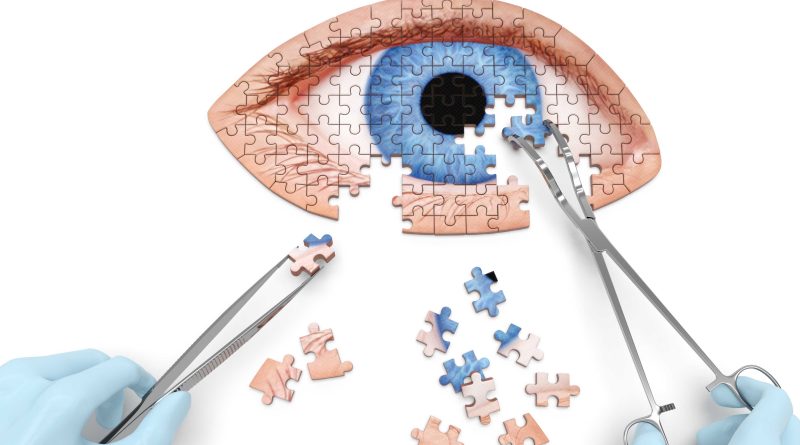Get Your Focus Right
Want to know what causes cataract; how it can be prevented; how is it detected; how it affects the vision, can problems develop after surgery; what are the latest surgical interventions to treat cataract? Read on …
By Amresh K Tiwary
If you are experiencing symptoms like blurry vision, trouble seeing at night, fading of colours, increased sensitivity to glare, halos surrounding lights and double vision in the affected eye, you must immediately seek medical advice, as these are unmistakable signs of cataract,
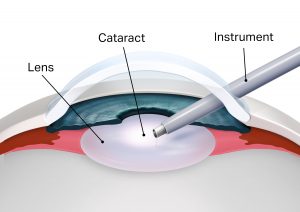 A cataract can occur in either or both eyes. It cannot spread from one eye to the other. It can interfere with daily activities and lead to blindness when left untreated. Although it may stop growing, it does not get smaller on its own.
A cataract can occur in either or both eyes. It cannot spread from one eye to the other. It can interfere with daily activities and lead to blindness when left untreated. Although it may stop growing, it does not get smaller on its own.
Cataracts are common among people over 60 years old but can occur at any age. As people age, the inner lens of the eye becomes cloudy. This results in hazy vision, glare from lights and distortion of colour. The surgical removal of cataracts is a very common and highly effective procedure, and the standard treatment for cataracts. The cloudy natural lens is removed, and an artificial lens is implanted in the eye. After surgery, vision should be clear.
 Causes of Cataract
Causes of Cataract
Says Dr Sanjay Chaudhary, Chairman and Managing Director, Eye 7 Group of Hospitals, New Delhi, well known for providing affordable eye care using the latest diagnostic and surgical technology, “Cataract is a dense, cloudy area that forms in the lens of the eye. It begins when proteins in the eye form clumps that prevent the lens from sending clear images to the retina. The retina, as we know, works by converting the light that comes through the lens into signals. It sends the signals to the optic nerve.”
There are several underlying causes of cataracts. These include an overproduction of oxidants, which are oxygen molecules that have been chemically altered due to normal daily life include smoking, ultraviolet radiation, the long-term use of steroids and other medications, certain diseases, such as diabetes, trauma and radiation therapy.
As Dr Sanjay Chaudhary elaborates, there are different types of cataracts. They are classified based on where and how they develop in your eye. Nuclear cataracts form in the middle of the lens and cause the nucleus, or the centre, to become yellow or brown. Cortical cataracts are wedge-shaped and form around the edges of the nucleus. Posterior capsular cataracts form faster than the other two types and affect the back of the lens. Congenital cataracts, which are present at birth or form during a baby’s first year, are less common than age-related cataracts. Secondary cataracts are caused by disease or medications. Diseases that are linked with the development of cataracts include glaucoma and diabetes.
 Dr Shishir Narayan, Senior Eye Specialist, Eye Trust, Ghaziabad and Associated with Shroff Eye Hospital, New Delhi, informs, “The use of the steroid prednisone and other medications can sometimes lead to cataracts. Traumatic cataracts develop after an injury to the eye, but it can take several years for this to happen. Radiation cataracts can form after a person undergoes radiation treatment for cancer. Risk factors associated with cataracts include: older age, heavy alcohol use, smoking, obesity, high blood pressure, previous eye injuries, a family history of cataracts, too much sun exposure, diabetes exposure to radiation from X-rays and cancer treatments.”
Dr Shishir Narayan, Senior Eye Specialist, Eye Trust, Ghaziabad and Associated with Shroff Eye Hospital, New Delhi, informs, “The use of the steroid prednisone and other medications can sometimes lead to cataracts. Traumatic cataracts develop after an injury to the eye, but it can take several years for this to happen. Radiation cataracts can form after a person undergoes radiation treatment for cancer. Risk factors associated with cataracts include: older age, heavy alcohol use, smoking, obesity, high blood pressure, previous eye injuries, a family history of cataracts, too much sun exposure, diabetes exposure to radiation from X-rays and cancer treatments.”
“The most common tonometry test uses a painless puff of air to flatten your cornea and test your eye pressure. Your doctor will also put drops in your eyes to make your pupils bigger. This makes it easier to check the optic nerve and retina at the back of your eye for damage. Other tests your doctor might perform include checking your sensitivity to glare and your perception of colours,” adds Dr Shishir Narayan.
 According to Dr Rajesh Ranjan, Eye Surgeon, Eye 7 Hospital, Indirapuram, Ghaziabad, the lens lies behind the iris and the pupil. It works much like a camera lens. It focuses light onto the retina at the back of the eye, where an image is recorded. The lens also adjusts the eye’s focus, letting us see things clearly both up close and far away. The lens is made of mostly water and protein. The protein is arranged in a precise way that keeps the lens clear and lets light pass through it.
According to Dr Rajesh Ranjan, Eye Surgeon, Eye 7 Hospital, Indirapuram, Ghaziabad, the lens lies behind the iris and the pupil. It works much like a camera lens. It focuses light onto the retina at the back of the eye, where an image is recorded. The lens also adjusts the eye’s focus, letting us see things clearly both up close and far away. The lens is made of mostly water and protein. The protein is arranged in a precise way that keeps the lens clear and lets light pass through it.
“But as we age, some of the protein may clump together and start to cloud a small area of the lens. This is a cataract. Over time, the cataract may grow larger and cloud more of the lens, making it harder to see. Still the researchers suspect that there are several causes of cataract, such as smoking and diabetes. Or, it may be that the protein in the lens just changes from the wear and tear it takes over the years,” explains Dr Rajesh Ranjan.
Treatment of Cataract
Dr Sanjay Chaudhary informs, “To treat Cataract we usually suggest stronger eyeglasses, magnifying lenses, or sunglasses with an anti-glare coating. Surgery is recommended when cataracts prevent you from going about your daily activities, such as reading or driving. It’s also performed when cataracts interfere with the treatment of other eye problems. One surgical method, known as phacoemulsification, involves the use of ultrasound waves to break the lens apart and remove the pieces. Extra capsular surgery involves removing the cloudy part of the lens through a long incision in the cornea.”
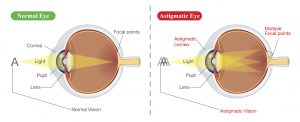
After surgery, an artificial intraocular lens is placed where the natural lens was. Surgery to remove a cataract is generally very safe and has a high success rate. Most people can go home the same day as their surgery.
Dr Sanjay Chaudhary says, “The symptoms of early cataract may be improved with new eyeglasses, brighter lighting, anti-glare sunglasses, or magnifying lenses. If these measures do not help, surgery is the only effective treatment. Surgery involves removing the cloudy lens and replacing it with an artificial lens.”
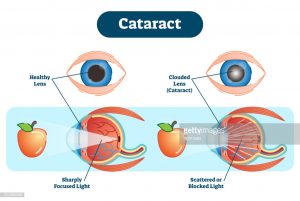
“A cataract needs to be removed only when vision loss interferes with your everyday activities, such as driving, reading, or watching TV. We can make this decision with patient. Once patient understands the benefits and risks of surgery, he/she can make an informed decision about whether cataract surgery is right for his/her. In most cases, delaying cataract surgery will not cause long-term damage to the eye or make the surgery more difficult. One does not have to rush into surgery,” Dr Chaudhary adds.
Sometimes a cataract should be removed even if it does not cause problems with your vision. For example, a cataract should be removed if it prevents examination or treatment of another eye problem, such as age-related macular degeneration or diabetic retinopathy. If you choose surgery, your eye care professional may refer you to a specialist to remove the cataract. If you have cataracts in both eyes that require surgery, the surgery will be performed on each eye at separate times, usually four weeks apart. Many people who need cataract surgery also have other eye conditions, such as age-related macular degeneration or glaucoma. If you have other eye conditions in addition to cataract, talk with your doctor. Learn about the risks, benefits, alternatives, and expected results of cataract surgery.”
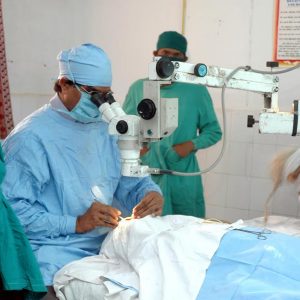 Dr Shishir Narayan says, “Cataract surgery slightly increases risk of retinal detachment. Other eye disorders, such as high myopia (nearsightedness), can further increase risk of retinal detachment after cataract surgery. One sign of a retinal detachment is a sudden increase in flashes or floaters. Floaters are little “cobwebs” or specks that seem to float about in field of vision. If you notice a sudden increase in floaters or flashes, see an eye care professional immediately. A retinal detachment is a medical emergency. If necessary, go to an emergency service or hospital. One’s eye must be examined by an eye surgeon as soon as possible. A retinal detachment causes no pain. Early treatment for retinal detachment often can prevent permanent loss of vision. The sooner you get treatment, the more likely you will regain good vision. Even if you are treated promptly, some vision may be lost.
Dr Shishir Narayan says, “Cataract surgery slightly increases risk of retinal detachment. Other eye disorders, such as high myopia (nearsightedness), can further increase risk of retinal detachment after cataract surgery. One sign of a retinal detachment is a sudden increase in flashes or floaters. Floaters are little “cobwebs” or specks that seem to float about in field of vision. If you notice a sudden increase in floaters or flashes, see an eye care professional immediately. A retinal detachment is a medical emergency. If necessary, go to an emergency service or hospital. One’s eye must be examined by an eye surgeon as soon as possible. A retinal detachment causes no pain. Early treatment for retinal detachment often can prevent permanent loss of vision. The sooner you get treatment, the more likely you will regain good vision. Even if you are treated promptly, some vision may be lost.
 Prevention of Cataract
Prevention of Cataract
Dr Anju Sharma, Eye Surgeon, Eye 7 Hospital, New Delhi, says, “To reduce your risk of developing cataracts: protect your eyes from UVB rays by wearing sunglasses outside, have regular eye exams, stop smoking, eat fruits and vegetables that contain antioxidants, maintain a healthy weight, keep diabetes and other medical conditions in check.”
“The lens is a clear part of the eye that helps to focus light, or an image, on the retina. The retina is the light-sensitive tissue at the back of the eye. In a normal eye, light passes through the transparent lens to the retina. Once it reaches the retina, light is changed into nerve signals that are sent to the brain. The lens must be clear for the retina to receive a sharp image. If the lens is cloudy from a cataract, the image you see will be blurred,” adds Dr Anju Sharma.
How does cataract affect vision?
According to Dr Shishir Narayan, age-related cataracts can affect vision in two ways: Clumps of protein reduce the sharpness of the image reaching the retina. The lens consists mostly of water and protein. When the protein clumps up, it clouds the lens and reduces the light that reaches the retina. The clouding may become severe enough to cause blurred vision. Most age-related cataracts develop from protein clumping. When a cataract is small, the cloudiness affects only a small part of the lens. You may not notice any changes in your vision. Cataracts tend to “grow” slowly, so vision gets worse gradually.
Over time, the cloudy area in the lens may get larger, and the cataract may increase in size. Seeing may become more difficult. Your vision may get duller or blurrier. The clear lens slowly changes to a yellowish/brownish colour, adding a brownish tint to vision. As the clear lens slowly colours with age, your vision gradually may acquire a brownish shade. At first, the amount of tinting may be small and may not cause a vision problem.
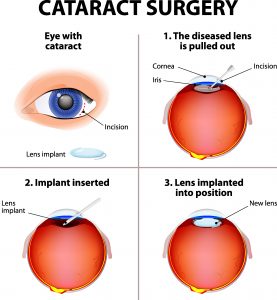 Over time, increased tinting may make it more difficult to read and perform other routine activities. This gradual change in the amount of tinting does not affect the sharpness of the image transmitted to the retina. If you have advanced lens discolouration, you may not be able to identify blues and purples. You may be wearing what you believe to be a pair of black socks, only to find out from friends that you are wearing purple socks.
Over time, increased tinting may make it more difficult to read and perform other routine activities. This gradual change in the amount of tinting does not affect the sharpness of the image transmitted to the retina. If you have advanced lens discolouration, you may not be able to identify blues and purples. You may be wearing what you believe to be a pair of black socks, only to find out from friends that you are wearing purple socks.
According to Anju Sharma, the term age-related is a little misleading. You don’t have to be a senior citizen to get this type of cataract. In fact, people can have an age-related cataract in their 40s and 50s. But during middle age, most cataracts are small and do not affect vision. It is after age 60 that most cataracts cause problems with a person’s vision. The risk of cataract increases as you get older. Other risk factors for cataract include certain diseases (for example, diabetes), personal behaviour (smoking, alcohol use) and the environment (prolonged exposure to ultraviolet sunlight).
Dr Sanjay Chaudhary, elaborates, “The symptoms of cataract also can be a sign of other eye problems. If you have any type of symptoms, check with your eye care professional. Although most cataracts are related to aging, there are other types of cataract include Secondary cataract that can form after surgery for other eye problems, such as glaucoma. Cataracts also can develop in people who have other health problems, such as diabetes. Cataracts are sometimes linked to steroid use. Traumatic cataract can develop after an eye injury, sometimes years later. Some babies are born with congenital cataracts or develop them in childhood, often in both eyes. These cataracts may be so small that they do not affect vision. If they do, the lenses may need to be removed. Radiation cataract can develop after exposure to some types of radiation.”
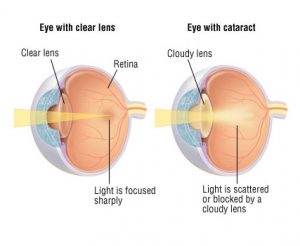 How is a cataract detected?
How is a cataract detected?
Dr Rajesh Ranjan explains, “Cataract is detected through a comprehensive eye exam that includes Visual acuity test that measures how well the patient sees at various distances. In Dilated eye exam, drops are placed in the eyes to widen, or dilate, the pupils. We use a special magnifying lens to examine your retina and optic nerve for signs of damage and other eye problems. After the exam, patient’s close-up vision may remain blurred for several hours. In Tonometry, an instrument measures the pressure inside the eye. Numbing drops may be applied to the eye for this test. We also may do other tests to learn more about the structure and health of your eye.
Can problems develop after surgery?
According to Dr Sanjay Chaudhary, problems after surgery are rare, but they can occur. These problems can include infection, bleeding, inflammation (pain, redness, and swelling), and loss of vision, double vision, and high or low eye pressure. With prompt medical attention, these problems can usually be treated successfully.
Sometimes the eye tissue that encloses the IOL becomes cloudy and may blur your vision. This condition is called an after-cataract. An after-cataract can develop months or years after cataract surgery.
An after-cataract is treated with a laser. We use a laser to make a tiny hole in the eye tissue behind the lens to let light pass through. This outpatient procedure is called a YAG laser capsulotomy. It is painless and rarely results in increased eye pressure or other eye problems. As a precaution, your doctor may give you eye drops to lower your eye pressure before or after the procedure.
Contoura Vision Surgery
Contoura Vision refractive surgery is a specialized type of LASIK surgery. Contoura Vision provides better outcomes because it corrects irregularities of the cornea that contribute to poor vision. More than 22,000 points are mapped on the cornea’s surface. Using this data, specialists at Eye7 Chaudhary Eye Centre create a profile of the patient’s cornea and devise an individualized treatment unique plan for vision correction. A study by the U.S. Food and Drug Administration reports that 92.6 percent of eyes treated using Contoura Vision surgery had vision outcomes of 6/6 or better after one year. Vision is sharper than corrective lenses and other LASIK procedures, the healing time is faster and no hospitalization is required.
Only five hospitals in India are certified to perform Contoura Vision surgery. Three are in Delhi, one is in Chennai and one is in Hyderabad. Eye7 Chaudhary Eye Centre is one of these five outstanding hospitals. They are the first to introduce this procedure to the NCR, and have performed more Contoura Vision surgeries than any other hospital in the region. Their facility is the only one in the Delhi region specifically dedicated to vision health.
LASIK Surgery
LASIK surgery has been the traditional treatment to correct nearsightedness, farsightedness and astigmatism for decades. Several LASIK procedures are available at their vision centres. The most advanced is bladeless LASIK. In this procedure, a Femtosecond laser cuts a flap on the cornea, and an excimer laser is used to correct vision.
Blade LASIK treatment is offered to patients who may not qualify for Contoura Vision or bladeless procedures. This technique uses a fine blade to create the flap in the cornea. The excimer laser corrects vision as in bladeless procedures.
Surface laser surgery is available for patients who have thin corneas or other conditions that make the blade and bladeless LASIK treatments unsuitable. This technique removes the outer layer of the cornea, and vision correction is done like other LASIK procedures. The outer layer regenerates in three to four days.
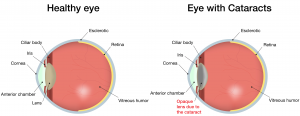 At Eye7 Chaudhary Eye Centre, doctors perform all types of LASIK surgery. They carefully evaluate each patient to determine the procedure that will provide the best visual outcome. They talk with you about your overall health, vision expectations, budget and lifestyle. These factors also contribute to the formulation of a treatment plan that is tailored to meet your needs.
At Eye7 Chaudhary Eye Centre, doctors perform all types of LASIK surgery. They carefully evaluate each patient to determine the procedure that will provide the best visual outcome. They talk with you about your overall health, vision expectations, budget and lifestyle. These factors also contribute to the formulation of a treatment plan that is tailored to meet your needs.
Implantable Collamer Lenses (ICL)
Implantable Collamer Lenses, thin lenses made of a biocompatible material, are surgically implanted behind the iris. The natural lens of the eye is not removed. ICLs function like contact lenses by correcting nearsightedness, farsightedness and astigmatism. However, unlike contact lenses, ICL lenses are permanent. ICL surgery is a good option for patients who cannot undergo LASIK treatment. The procedure is reversible.
Dr. Chaudhary is a pioneer in ICL surgery in India. He has more than 12 years of experience with ICL implants. His dedication to eye health is demonstrated by his professional services. He fosters continuing medical education throughout the world by performing live surgeries broadcast to international ophthalmologists and has written professional papers that discuss innovative ways to treat ICL patients.
Latest research on cataract
The National Eye Institute is conducting and supporting a number of studies focusing on factors associated with the development of age-related cataract. These studies include the effect of sunlight exposure, which may be associated with an increased risk of cataract, vitamin supplements, which have shown varying results in delaying the progression of cataract. These studies show promise for a better understanding of cataract development.

